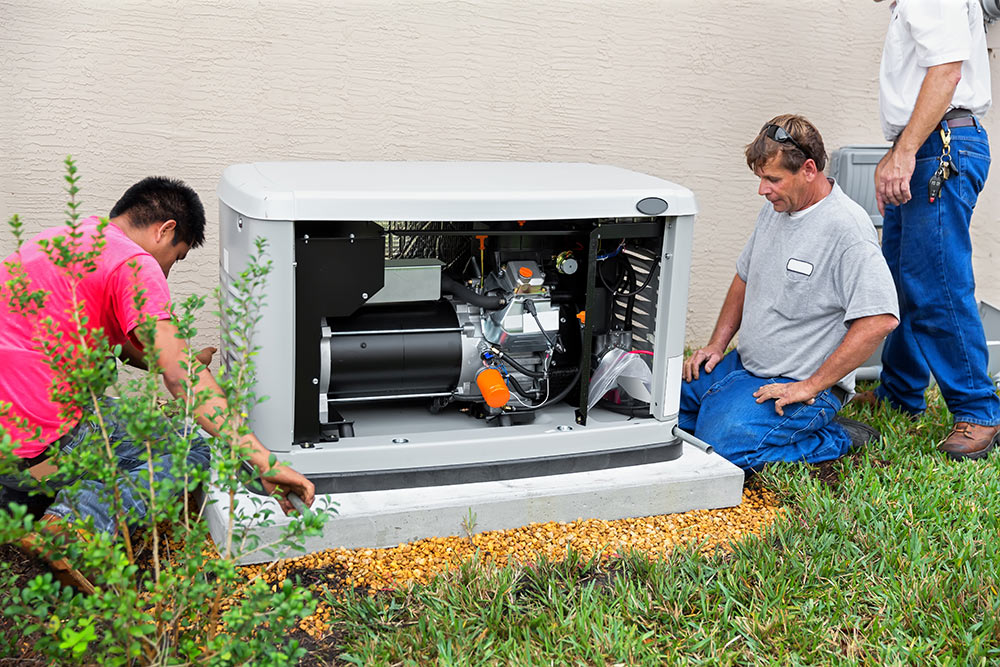To get an estimate on installing a generator, please call us at 954.922.3800 or fill out the form below:
ABOUT THE GENERATOR INSTALLATION PROCESS- inspection
Quality Installation Services
Home Stand-By Generators:
Stand-by generators automatically power your home during an outage without any input from you. They’re permanently installed, connected to your electrical system, and switch on when power is lost. Installation requires licensed professionals in multiple trades. Choosing the right system means selecting the correct size, brand, and location. Empower Generators handles the process from start to finish, ensuring safety, compliance, and peace of mind.
Sizing:
Your generator must match your home’s power needs. Options include full-home coverage, load-shedding systems, or select circuits. We analyze your setup to recommend the right fit. Even if unlikely, your generator must handle full usage in case everything is on during an outage. Proper sizing means reliable performance with no interruptions or overload risks.
Manufacturer:
Empower works with top brands—Generac, Kohler, Cummins, and Briggs & Stratton. All offer strong products, but some are better for specific homes or preferences. We help you choose based on performance, reliability, and installation compatibility. Our goal is to match you with a system that works for your needs and budget.
Location:
Placement must meet city codes for spacing from structures and property lines. These rules vary, and our team knows how to navigate them. We help select a compliant and practical spot. Once the site is chosen, we handle everything from permitting to final installation—keeping the process smooth and stress-free.
Installation:
We handle your entire installation. It begins with a consultation, followed by permitting, delivery, setup, electrical and gas connections, and inspections. A certified tech performs the final startup and gives you a walkthrough. Empower manages each step, so you don’t have to.
Consultation – Every installation starts with a free in-home visit. Our expert assesses your needs, inspects your electrical setup, and provides a proposal with pricing and scope. This visit takes about an hour.
Permit Preparation – Once approved, we gather and prepare all documents required by your city—electrical drawings, structural pad details, and gas system plans. This phase takes the most time in the project.
Permit Submittal/Acquisition – We submit the complete permit package to your city. Approval typically takes 2–4 weeks and involves reviews by multiple departments. We handle revisions and track status until approved.
Delivery – We level the site, install the concrete pad, and anchor the generator. You’re encouraged to be present to confirm placement. This takes 1–2 hours depending on site access.
Electrical Connections – We install the transfer switch and conduit, then pull wires and complete final connections. Power will be off for 2–4 hours during this. Trenching is about 24” deep and 1’ wide. This phase takes 1–2 weeks with inspections.
Gas Connections – Gas lines are installed after electrical work. For propane, we dig and set the tank before connecting it. Trenches are about 18” deep. After inspection, we backfill and complete connections. This takes about one week.
Start-Up – A certified tech installs the battery, connects control wires, registers the warranty, and runs startup tests to confirm everything works. This takes 1–2 hours.
Orientation – We show you how to operate and monitor your generator, explain basic functions, maintenance, and emergency procedures.
FAQ
ABOUT THE GENERATOR INSTALLATION PROCESS
At Empower Generators, we want you to have an effective generator, which is why we carefully walk you through the process and install your generator correctly. We are a trusted company to turn to when you are considering installing a generator because we have known the process and have been helping customers for several years. Empower Generators is dedicated to providing exceptional service to each individual in need of guaranteed power.
STEPS A GENERATOR INSTALLER PERFORMS
There are a number of steps to take when you move forward with the process of installing a generator. Some of these steps you may not know about, but they are critical to proper generator installation. At Empower Generators, we are dedicated to providing a safe, thoroughly placed generator where you are located.
Design Layout for Approval
The first part of the generator installation process involves the engineering. This is critical because the way that the plan reads will determine whether the generator is permissible in the chosen location. As far as engineering of your generator is concerned, a well-structured electric and gas engineered drawing is essential for the municipality to permit.
Request Permit
Once the engineering drawing is created, the next part of the generator installation process is to move forward with the request for a permit. All generators require a permit prior to installation, but once you have your design layout for this, you can then move forward and wait for permission. Each municipality is different, so the answer may take some time depending on where you are located.
Deliver the Generator for Installation
Once you have been approved with a permit for a generator, then the generator installation process can really begin – but first, the generator has to be delivered to the location you will be placing it in.
Install the Generator
The generator will then be installed when it is in place. Electrical and gas connections will be made so that your generator is up and running.
Inspection
Once the generator is all set up, there will need to be a generator inspection. This inspection needs to be conducted by the municipality. Even once it is inspected, there will need to be more municipal inspections as well. The inspection process is important because it ensures that the generator is working safely and that all protocol is adhered to.
Having a generator comes with many benefits, and though to some the generator installation process may take some time to be completed, it is definitely worth it. There is nothing greater than having the guarantee of power [by generator] when the electricity goes out! For the best generators and proper generator installation, you can depend on Empower Generators.
HOW MUCH DOES A TYPICAL STAND-BY GENERATOR INSTALLATION COST?
Generator installations can vary greatly in price. Every home’s electrical system differs and each customer’s needs can vary greatly from another’s. Typically, South Florida homes up to 2500 sqft can be covered by an air-cooled generator. These machines can provide between 20-22kW depending on the manufacturer you choose which is a considerable amount of power for homes that size. These machines are dual fuel and can be hooked up to Natural Gas or Liquid Propane. About 40% of South Florida homes have natural gas availability. If NG is available, it is the ideal fuel source. Owners will enjoy an unlimited supply of gas and will avoid the need to install a LP tank. As a reference point, typical 20-22kW NG installations range from $12K-$15K depending on placement and other factors. Typical 20-22kW LP installations range from $15K -$18K depending on placement and other factors. These estimates are provided only as a guideline.
HOW LONG DOES IT TAKE TO INSTALL A STAND-BY GENERATOR?
Generator installations can typically take between 4-6 months. The majority of this time is spent preparing the permit package for submittal to the municipality. Once the permit is acquired the physical work takes about 2-4 weeks to complete inclusive of inspections.
WHAT IS THE LIFE EXPECTANCY OF A STAND-BY GENERATOR?
Stand-by generators usually have a useful life of 15-20 years. Certain factors like ambient heat, proximity to bodies of water and humid climates can greatly decrease the longevity of these machines. There are measures to take to ensure your generator has a long life including regular preventative maintenance and corrosion treatments.
ARE DIESEL GENERATORS BETTER THAN LP OR NG GENERATORS?
It is important to first learn the differences between Diesel generators and Gaseous Generators as well as the pros and cons of each before making a decision on which to purchase. Diesel generators are typically designed for commercial and industrial applications. They are robust and fuel efficient. Diesel fuel, however, requires maintenance whereas natural gas or propane do not. Diesel generators have a longer useful life than gaseous generators but are also typically more expensive. Gaseous generators dominate the residential market because they have become much more affordable. Additionally, diesel fuel cannot be stored underground. It needs to be held in an above-ground container usually below the generator which can make the equipment taller and inhibitive for residential applications. It is important to consider these factors when choosing a fuel source for your installation.




